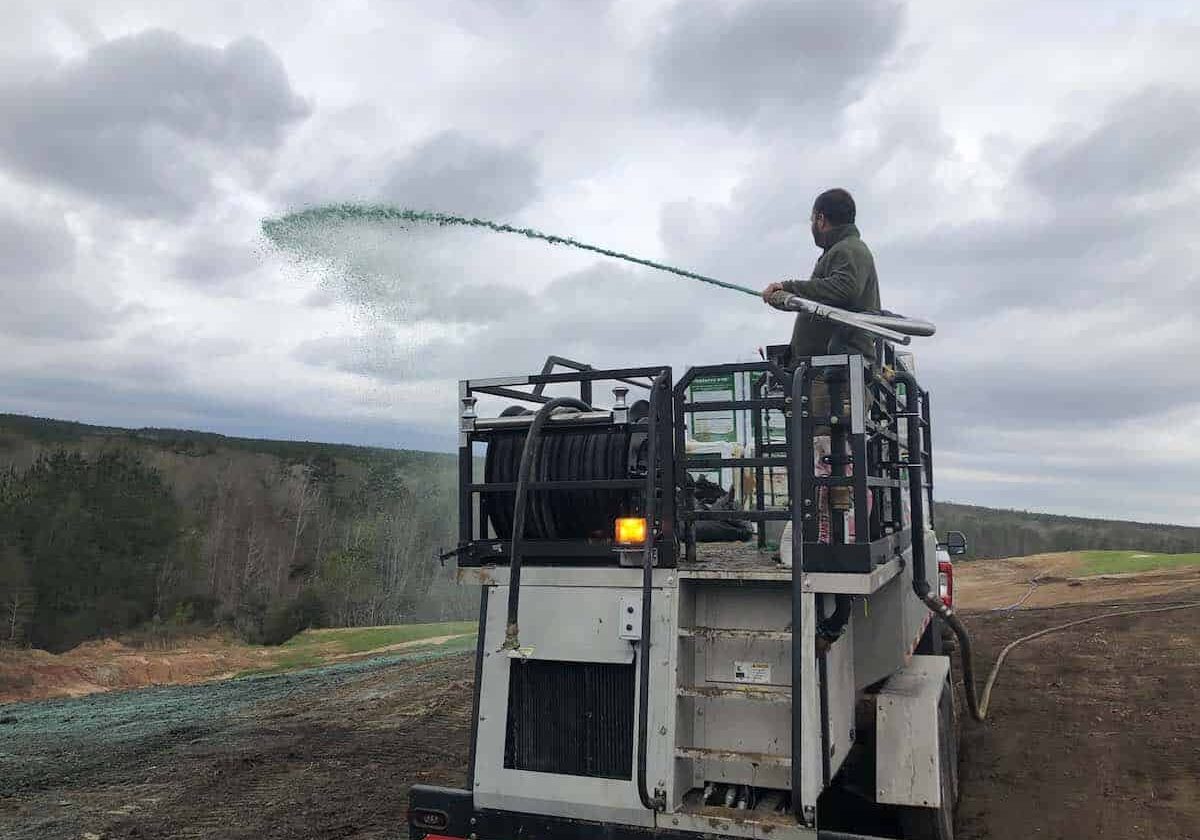Hydroseeding for Revegetation – A Cost-Effective Solution

Share this article!
Hydroseeding for revegetation is a cost effective, efficient revegetation solution for a variety of projects from roadside revegetation and construction site remediation to wildfire restoration, mining reclamation, and erosion control solutions. With its fast delivery, quick mixing slurry, seed type customizability, and minimal operator crew, the cost of revegetation projects can be significantly reduced using hydroseeding methods while providing dependable, uniform coverage of site-suitable vegetation.
Benefits of Hydroseeding for Revegetation
One of the most important benefits of hydroseeding for revegetation is the speed at which it can provide erosion control for disturbed areas that need to be replanted. Hand seeding, broadcast seeding, or planting shrubs and groundcovers by hand is a time consuming endeavor that often requires a large crew of people. Hydroseeding, by comparison, can cover a large area in a short period of time with crops or seeds that germinate quickly and establish root systems to help prevent runoff and erosion in the affected area. A crew of only a few experienced people is needed to complete large-scale hydroseeding jobs.
Hydroseeding for revegetation also improves plant growth, because the slurry can be mixed to include specialized fertilizers and tackifiers to support both healthy plant establishment, and reduce the amount of redistribution that can occur after seeding. The result is a healthy, uniform revegetation crop that provides consistent, long-term erosion control while significantly reducing overall revegetation costs.
Hydroseed Mixture Supports Germination & Growth
The hydroseed mixture, or slurry, can be customized to meet the specific needs of the planting area. If certain nutrients are lacking in the soil as a result of industrial activity, mining, or wildfire, fertilizers and growth stimulants can be added to the slurry before application to correct for this imbalance. Also, since the application of seeds, fertilizer, and mulch happens simultaneously with hydroseeding, the process helps seeds establish well with the nutrients they need to thrive, while staying put thanks to additions like mulch and tackifiers to prevent erosion and runoff.
Hydroseed slurry is mixed and applied with water, allowing for the planting of seeds of various varieties. This method ensures that the seeds have the necessary moisture to support germination and develop a strong root system in their new environment.
Native Plant Species Selection
Choosing the right seeds and plants for revegetation hydroseeding can help ensure even more success of the hydroseeding process. Native plants are a popular choice because the right native plants reduce water needs, establish and spread quickly with little fertilizer or other attention, and generally provide a more hardy solution for both revegetation and erosion control.
“Workhorse” plant varieties are also commonly used for similar reasons, as less water and maintenance are required to establish a vibrant revegetation crop. In the Western United States crops like Mountain Brome or Blue Wild Rye are often successful choices, while in other areas such as the Southeast, grasses like Fescues are common, as are nitrogen-fixing crops like Clover or Lupine.
The key to selecting successful native plant species for revegetation is research — consider: what plant types are native to the area, and among those, what is likely to grow well in the proposed area given its revegetation needs? Consulting a local expert, the US Forest Service, or the US Department of Agriculture can provide additional resources to answer these questions.
Weed and Pest Control
Revegetation efforts can easily be threatened by competing plants, particularly widespread invasive species like Japanese Knotweed or English Ivy. Choosing native plants for revegetation can provide some protection against invasive species taking root, however herbicides or pesticides are often the best way to ensure weeds and invasive plants don’t establish in the revegetation area.
Common pests like aphids or moths can threaten the success of revegetation methods, as they can eat through young plants, seeds, and sometimes roots. Choosing native plants can generally discourage pest populations, and using pesticides can minimize the likelihood that pests will interfere with revegetation.
Hydroseeding simplifies the herbicide and pesticide application process, since both can be added directly to hydroseeding slurry. Like fertilizers and tackifiers, these additives support the growth of the desired crop, while also discouraging unwanted weeds or pests.
Erosion Control
Many industrial and commercial projects come with erosion control and sediment runoff requirements for contractors, either at the federal or local level. One method to effectively control erosion in areas of disturbed land is to use hydroseeding.
The mulch and tackifiers commonly used in hydroseeding slurries help keep seeds in place while they establish, and as the root systems of the establishing seeds grows, they then contribute to the soil stabilization.
Reduced Revegetation Costs
The downside of revegetation with methods like hand seeding or transplanting are that they can be costly and time consuming. Days can be spent planting, fertilizing, and watering new plants and crops in disturbed areas, significantly impacting the cost of revegetation.
But with hydroseeding, a large area can be covered in mulch, fertilizers, herbicides, and tackifiers simultaneously to help new plants take root well. Depending on the size of the area, this can all be done in a matter of hours. This reduction in labor costs translates into huge savings for revegetation costs across a variety of different projects.
Hydroseeding Revegetation Applications
Given the effectiveness of hydroseeding, it’s no surprise that many industries are adopting some version of hydroseeding for revegetation projects. When you need to:
- Quickly and effectively establish ground cover, seed crops, or other small plants and brush across a large disturbed area,
- Meet federal erosion control and runoff requirements, or
- Revitalize an area after wildfire, commercial or industrial use,
Look to hydroseeding revegetation solutions for:
Wildfires
Hydroseeding can be used effectively to re-establish native plants and grasses in areas impacted by wild and forest fires. Because it can cover large areas relatively quickly, hydroseeding for wildfire revegetation is often a perfect fit to help large areas of land rebound quickly after the devastation of a fire.
Hydroseeding is an especially beneficial method for revegetation after fires because it can successfully seed hard-to-reach areas where fires often burn, whether that’s steep gorges, canyons, or otherwise inaccessible terrain. You can also count on the uniform germination that comes with the hydroseeding method, as well as the speed of application.
Roadside Revegetation
Highway construction and roadside projects often result in sloping terrain that needs to be stabilized quickly. Using hydroseeding for this process can quickly establish seeds selected specifically for erosion control on embankments or slopes. Roadside revegetation with hydroseeding is effective because a variety of seeds can be chosen to suit the specific needs of the environment, while mulch and tackifiers can be applied simultaneously to minimize runoff and uneven seed distribution.
State and National Parks
Revegetation is an integral part of keeping National Parks and State Parks safe and healthy, both for visitors and the larger ecosystem. Revegetation efforts in these areas need to meet certain criteria to comply with regulations, and the unique environment of each park. Plant species need to be chosen carefully and with input from local experts to support other native plant and animal species, as well as meeting erosion control and soil stabilization goals.
The ability to combine different types of seeds, and to hand select seed species to plant over a large area, makes hydroseeding for revegetation in National Parks one of the most dependable and cost effective methods to establish a new plant layer in disturbed areas.
Mining Operations
Mining operations have a notoriously detrimental impact on the greater environment, from soil degradation and compaction to erosion and pollution. In order to mitigate these impacts, many mining operations must comply with federal and local regulations to revegetate disturbed areas, and this recommendation often includes using native plant species and cover crops to stabilize large areas of soil.
Hydroseeding has been used for revegetation in mining operations with success because seeds can be spread in almost any grade of terrain, making it perfect for the sloping sides and steep pitches that accompany mining operations. Because crops quickly establish, hydroseeding for mining operations can help prevent the large amounts of soil erosion, runoff and waterway pollution occurring after mining operations.
Construction Activities
Hydroseeding for revegetating construction sites can help ensure contracted projects are completed to code, and within the time constraints that can come along with large-scale construction projects.
Construction site revegetation can be effectively achieved through the use of hydroseeding, especially due to its flexibility and reliable outcomes. Seeds are broadcast uniformly and consistently across a variety of terrain with moisture and the nutrients they need, and this can often be done by an individual or a small team, and in just a few hours, depending on the size of the disturbed area.
Conclusion
For cost effective revegetation methods, hydroseeding is a flexible choice that offers professional-quality results, typically with less time and effort than other methods.If you’re looking for more efficient ways to meet revegetation requirements, or revitalize disturbed land after fires, construction, or mining, our experts are here to help. Contact us today or learn more in our online resources.
